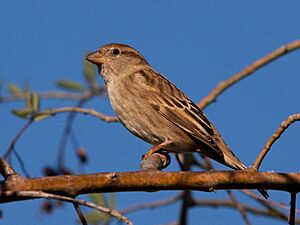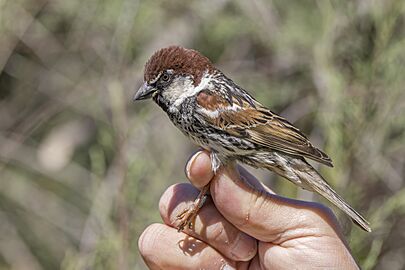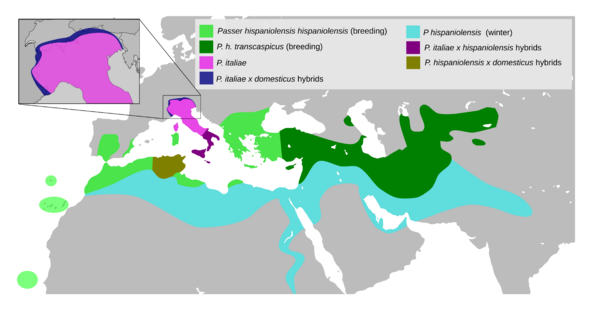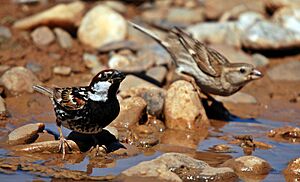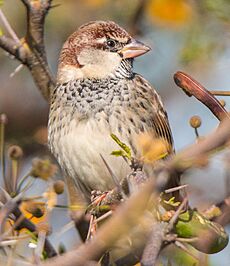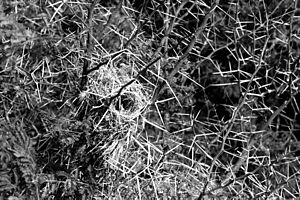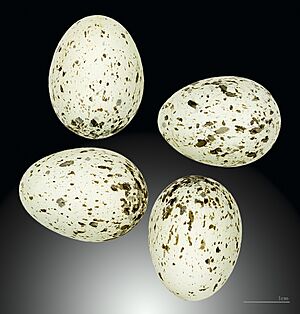Spanish sparrow facts for kids
Quick facts for kids Spanish sparrow |
|
|---|---|
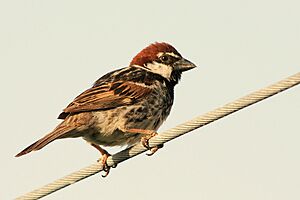 |
|
| Male in Sardinia | |
| Conservation status | |
| Scientific classification |
The Spanish sparrow or willow sparrow (Passer hispaniolensis) is a type of bird in the sparrow family. You can find it in the Mediterranean region and parts of south-west and central Asia. This bird looks a lot like its close relative, the house sparrow. They are so similar that they often mix and have baby birds together in the Mediterranean. This makes it a bit tricky for scientists to tell them apart sometimes!
Contents
What Does the Spanish Sparrow Look Like?
The Spanish sparrow is a fairly large sparrow. It is about 15 to 16 centimeters (6 inches) long. It weighs between 22 and 36 grams (about 1 ounce). This makes it a little bigger and heavier than the house sparrow. It also has a slightly longer and stronger beak.
Male vs. Female Sparrows
Male Spanish sparrows look similar to house sparrows. But there are some key differences. Male Spanish sparrows have strong black stripes on their undersides. Their heads are a reddish-brown color, not grey. Also, their cheeks are white, not grey.
Female Spanish sparrows are very hard to tell apart from female house sparrows. They are mostly grey-brown. However, female Spanish sparrows have light stripes on their sides. They also have a pale cream stripe above their eye. Plus, they have wide cream stripes on their backs.
Two Types of Spanish Sparrows
Scientists recognize two main types, or subspecies, of the Spanish sparrow. These are the western Spanish sparrow (P. h. hispaniolensis) and the eastern Spanish sparrow (P. h. transcaspicus). When they are ready to breed, they look very much alike. It's easier to tell them apart in winter. The eastern type, P. h. transcaspicus, is usually paler. It also has less reddish-brown color.
What Sounds Do They Make?
The sounds the Spanish sparrow makes are much like those of the house sparrow. When a male is showing off at its nest, it makes a special call. This call has two loud, high-pitched chirps. It sounds like chweeng-chweeng, cheela-cheeli.
When birds arrive or leave their resting spots, they make a softer call. It sounds more like the house sparrow's tschilp. Other calls are almost the same as the house sparrow's. A soft quer quer quer is heard from pairs at the nest. Flocking birds make a quer-it call when flying. A chur-chur-it call is used as a warning.
How Scientists Classify Them
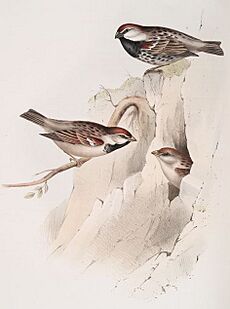
Understanding how the Spanish sparrow fits into the bird family tree can be tricky. This is because it often mixes with the house sparrow in the Mediterranean. In most of this area, one or both types of sparrows live. They usually don't mix much.
However, in Italy and on the island of Corsica, things are different. Here, you find the Italian sparrow. This bird seems to be a mix between the Spanish sparrow and the house sparrow. Scientists have debated if the Italian sparrow is a hybrid, a subspecies, or its own species.
The Spanish sparrow also mixes easily with the house sparrow in parts of North Africa. This happens in northeastern Algeria, Tunisia, and northwestern Libya. Here, you can find many different kinds of sparrows. They range from pure house sparrows to pure Spanish sparrows. On islands like Malta, Gozo, Crete, Rhodes, and Karpathos, there are also birds that seem to be a mix.
Naming the Spanish Sparrow
The Spanish sparrow was first described by a Dutch scientist named Coenraad Jacob Temminck. He called it Fringilla hispaniolensis. He found a bird in Algeciras, Spain. That's why its common English name is "Spanish sparrow." Sometimes it's called the "willow sparrow." This name refers to the wet places where it likes to live. The name Passer is the Latin word for sparrow. Hispaniolensis means "Spanish" in a newer form of Latin.
Where Do Spanish Sparrows Live?
The Spanish sparrow lives in many different places. You can find it in the Mediterranean region, the Macaronesia islands, and from southwest to central Asia. It mostly breeds in a wide band from the Danube Valley to Libya.
Over the last 200 years, its range has grown a lot. It has spread into the Balkans, reaching Romania, Serbia, and Moldova since the 1950s. It also spread to the Macaronesia islands. This was likely due to migrating birds.
Sometimes, Spanish sparrows wander far from their usual homes. They have been seen as far north as Scotland and Norway. Studies show that these wandering birds often appear near railway lines. This suggests that cargo trains might help them spread to new areas.
Western Spanish Sparrow Habitat
The western type, hispaniolensis, breeds in parts of Spain and North Africa. It also lives on some islands and in the Balkans. In Spain, it's not very common. It lives in the Tagus valley and other scattered areas. In northern Italy and Corsica, the Italian sparrow takes its place. The Spanish sparrow is not known to breed on the Balearic Islands or some Aegean Islands. But it does live on Sardinia and other smaller islands. In the Balkans, it lives in Montenegro, Romania, and northern Serbia. You can also find it in mainland Greece and Bulgaria, but it's not common there.
The Spanish sparrow has lived on the western Canary Islands for a long time. It was first seen on Lanzarote in 1828. By the 1830s, it was on Fuerteventura, Gran Canaria, and Tenerife. Since the 1940s, it has reached all the other Canary Islands. It arrived in Madeira in 1935 after strong winds. It seems to have reached Cape Verde around the same time as the Canaries. Charles Darwin first recorded it there in 1832. From then on, it spread to all the other larger islands.
Eastern Spanish Sparrow Habitat
The eastern type, transcaspicus, breeds from Anatolia and Cyprus through the Middle East and Central Asia to western China. In the Middle East, it breeds through Syria and Lebanon. It goes as far south as Jerusalem. It breeds in eastern Turkey. It is very rare in Iraq and Kuwait. It also breeds in Azerbaijan and Dagestan. In Iran, it breeds in most of the country. It also lives in central and northern Afghanistan. In Central Asia, it breeds from Turkmenistan to Kazakhstan and a part of China. Here, it has also spread its range. This happened around Lake Alakol in Kazakhstan, where farming started in the 1950s. In winter, it flies to the plains of India and the Persian Gulf.
Where They Like to Live
In most places, the Spanish sparrow lives alongside the house sparrow. In these areas, both birds breed in farmland and open woods. The Spanish sparrow prefers places that are wetter.
In areas where there are no house sparrows, the Spanish sparrow might live in cities. This happens in the Canary Islands, Madeira, and some Mediterranean islands. On some islands, like eastern Sardinia, the main sparrow is the Eurasian tree sparrow.
Before the Spanish sparrow came to the Canary Islands and Madeira, the rock sparrow was the only native sparrow. In the Canaries, the Spanish sparrow lives in most places. It has pushed the rock sparrow out of all but the driest areas. In Madeira, the Spanish sparrow is common in farmed areas. But it has not fully learned to nest in buildings. It also doesn't breed in the drier north of the island.
The Spanish sparrow is not common on most of the Cape Verde islands. This is because of the Iago sparrow, which lives only there. Also, the house sparrow lives on São Vicente. On Fogo, where it is the only sparrow, it is common everywhere. It nests in houses in São Filipe and on the cliff walls of the volcano Pico do Fogo.
Life Cycle and Habits
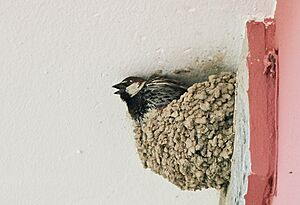
The Spanish sparrow loves to be in groups. It flocks together and breeds in large colonies. In winter, it often moves around or makes regular migrations. We don't know much about how long Spanish sparrows live. The oldest one ever recorded lived for 11 years.
What They Eat
Like other sparrows, the Spanish sparrow mainly eats seeds from grains and other grasses. They also eat leaves, fruits, and other plant parts. Young birds mostly eat insects. Adult sparrows also eat insects and other small animals before and during the breeding season. Baby birds eat almost only insects for their first few days. Then, they slowly start eating more grains. Insects make up 75 to over 90 percent of what baby sparrows eat.
Spanish sparrows eat whatever insects are most common. In Central Asia, they eat caterpillars, ants, grasshoppers, and crickets. When they migrate through Central Asia in spring, they mostly eat crops from farms. When they are breeding, they mostly eat insects, wild plants, and seeds from the year before.
Reproduction
Spanish sparrows build their nests in large groups, called colonies. Their nests are often very close together, or even share parts. They usually build nests in trees or bushes. Sometimes, they build them under the nests of bigger birds, like white storks. These colonies can have from ten pairs to hundreds of thousands of pairs! Each pair lays 3 to 8 eggs. The eggs hatch in 12 days. The chicks are ready to leave the nest when they are about 14 days old. Male sparrows spend more time building the nests than females.
How Many Spanish Sparrows Are There?
In Europe, there are between 2.8 million and 6.2 million breeding pairs of Spanish sparrows. This means there are 8.4 million to 18.6 million individual birds. The total number of Spanish sparrows in the world is thought to be between 17 million and 74 million.
In some parts of Europe, their numbers have gone down. But in other areas, their population has grown. The species is not in serious danger. So, it is listed as "least concern" on the IUCN Red List. This means it's not currently at risk of disappearing.



